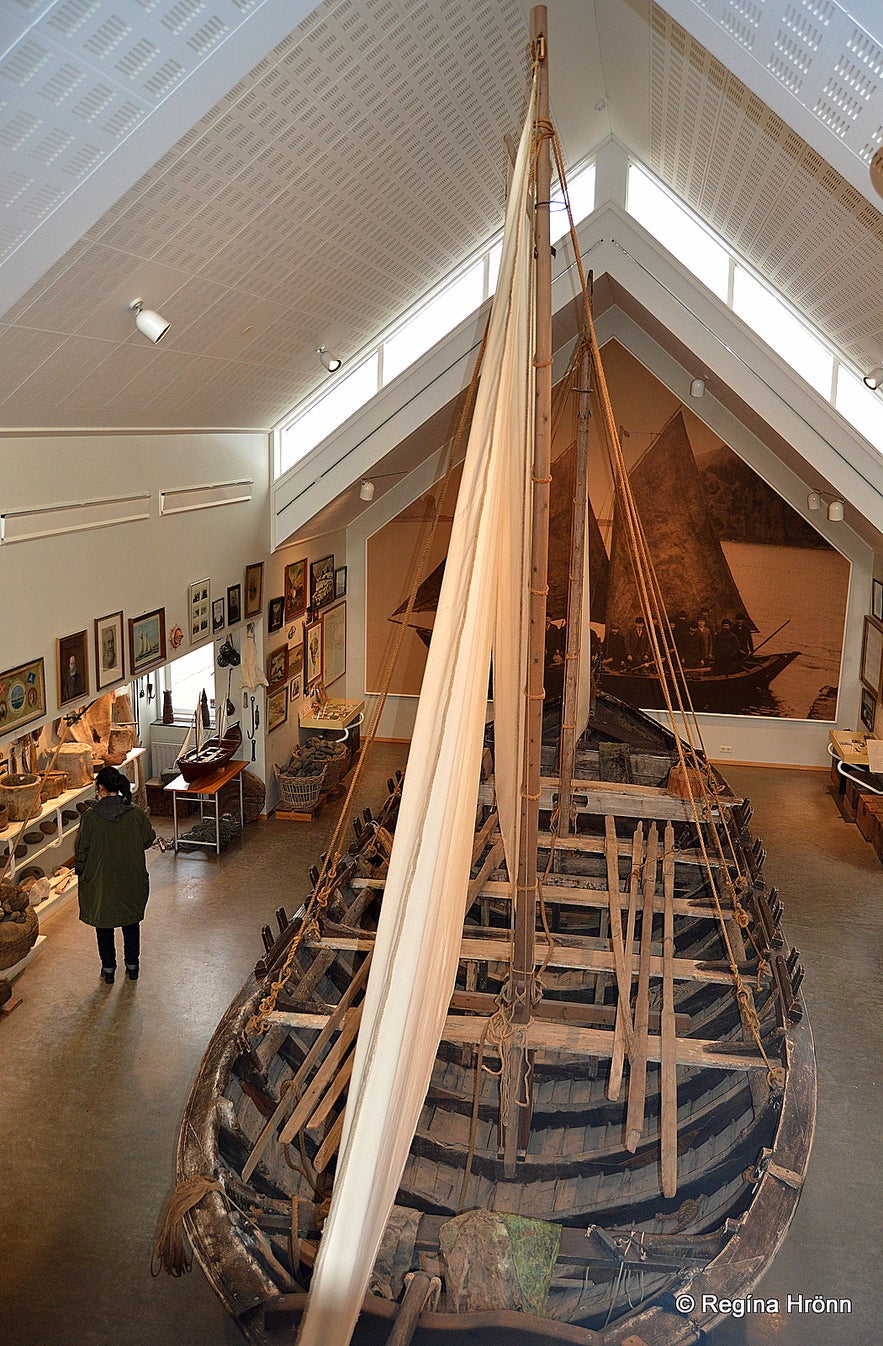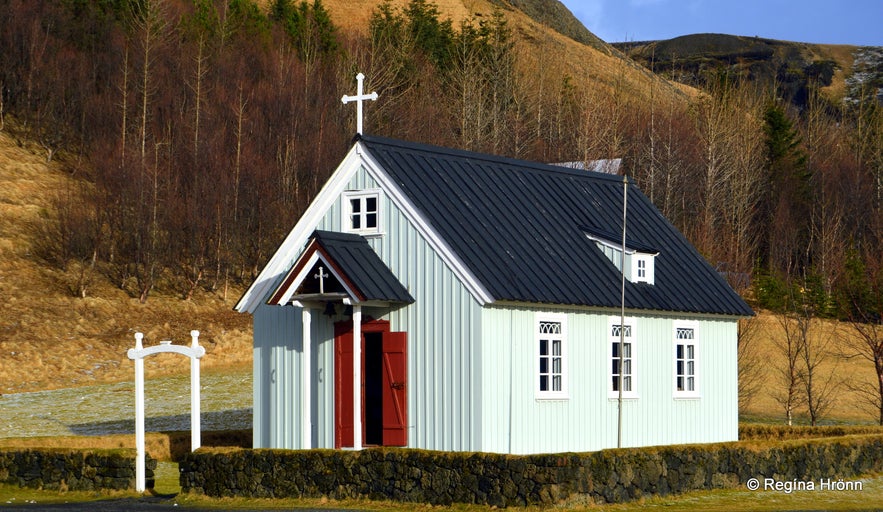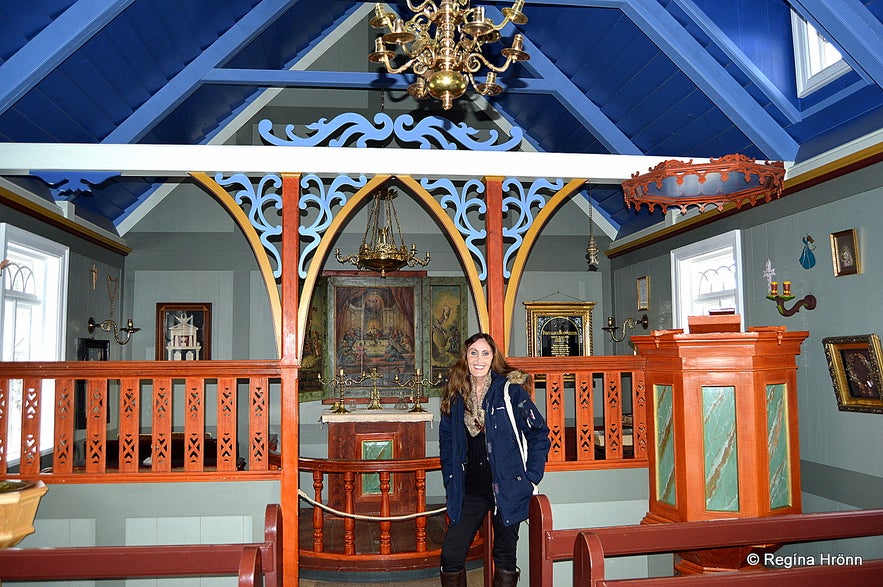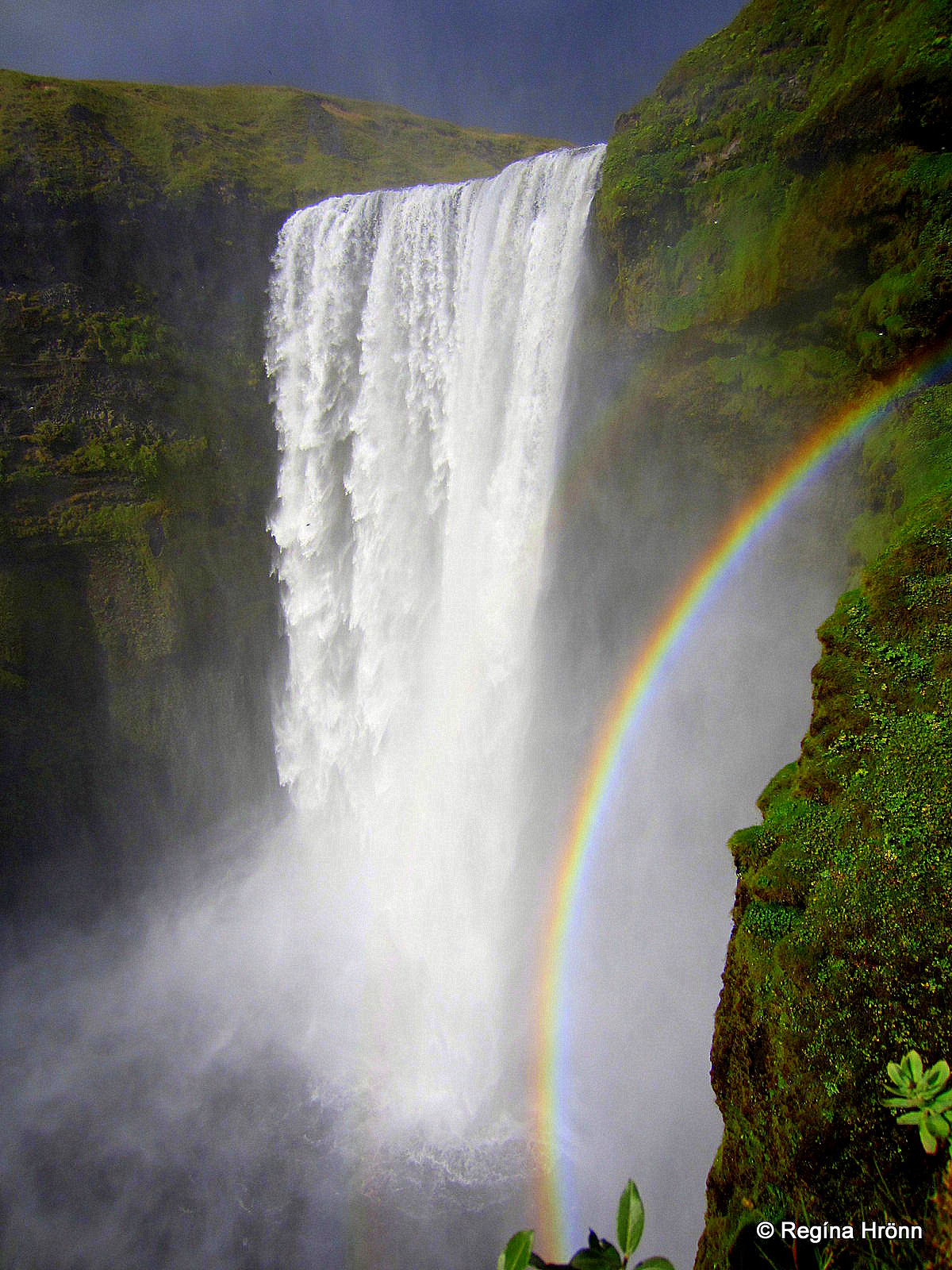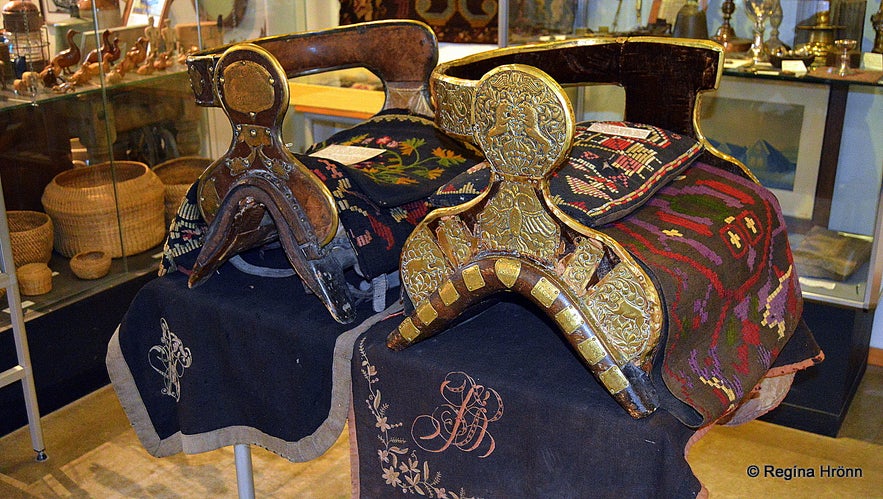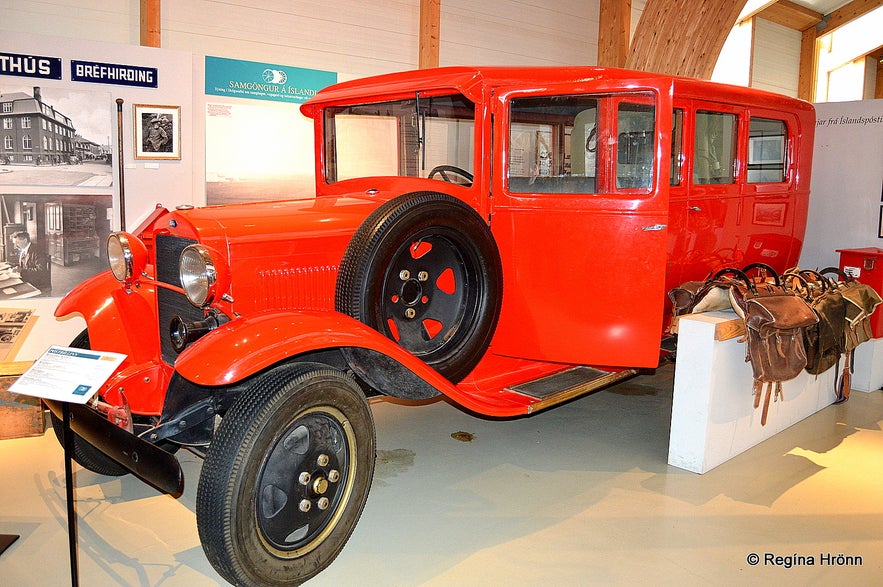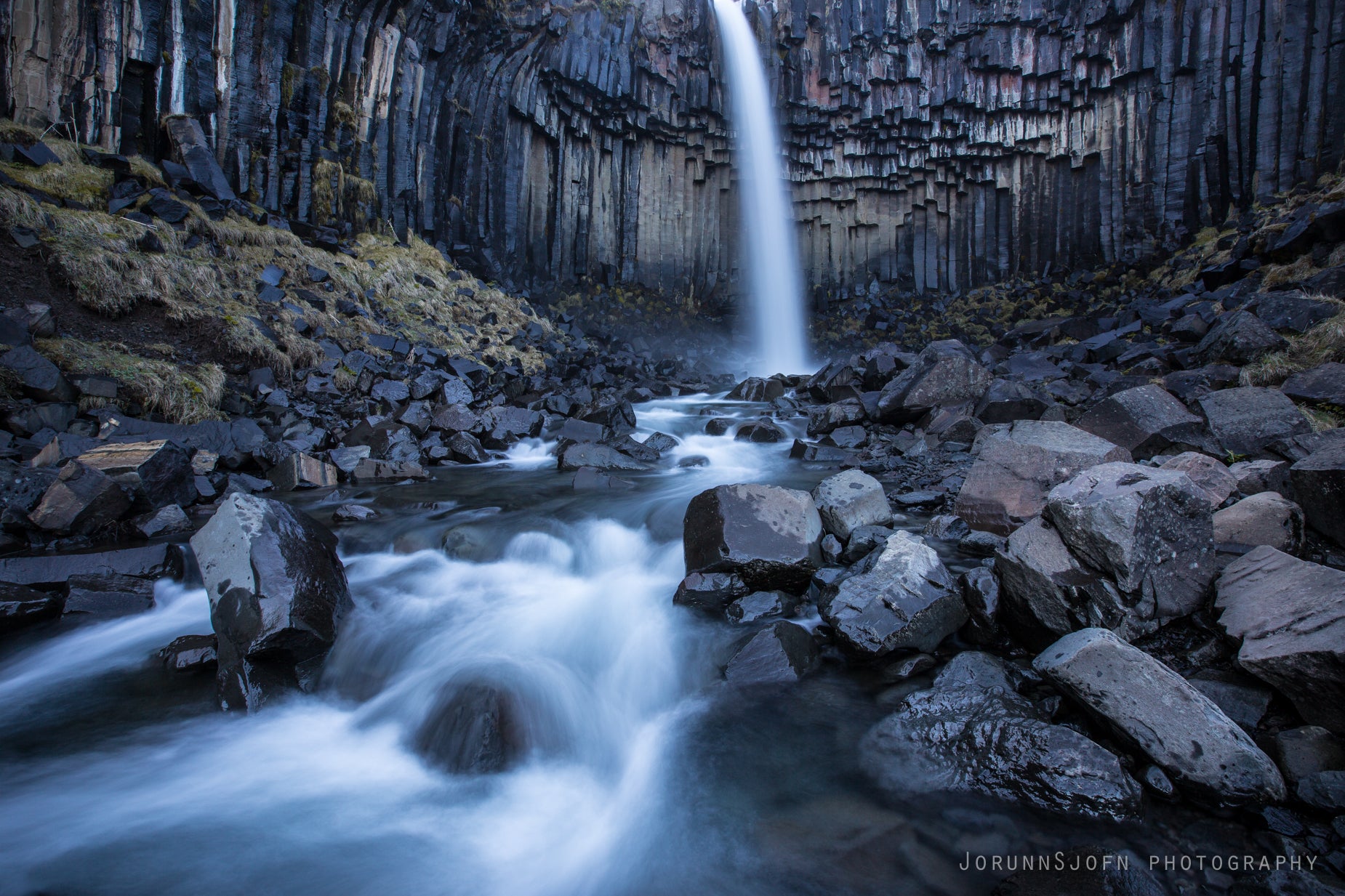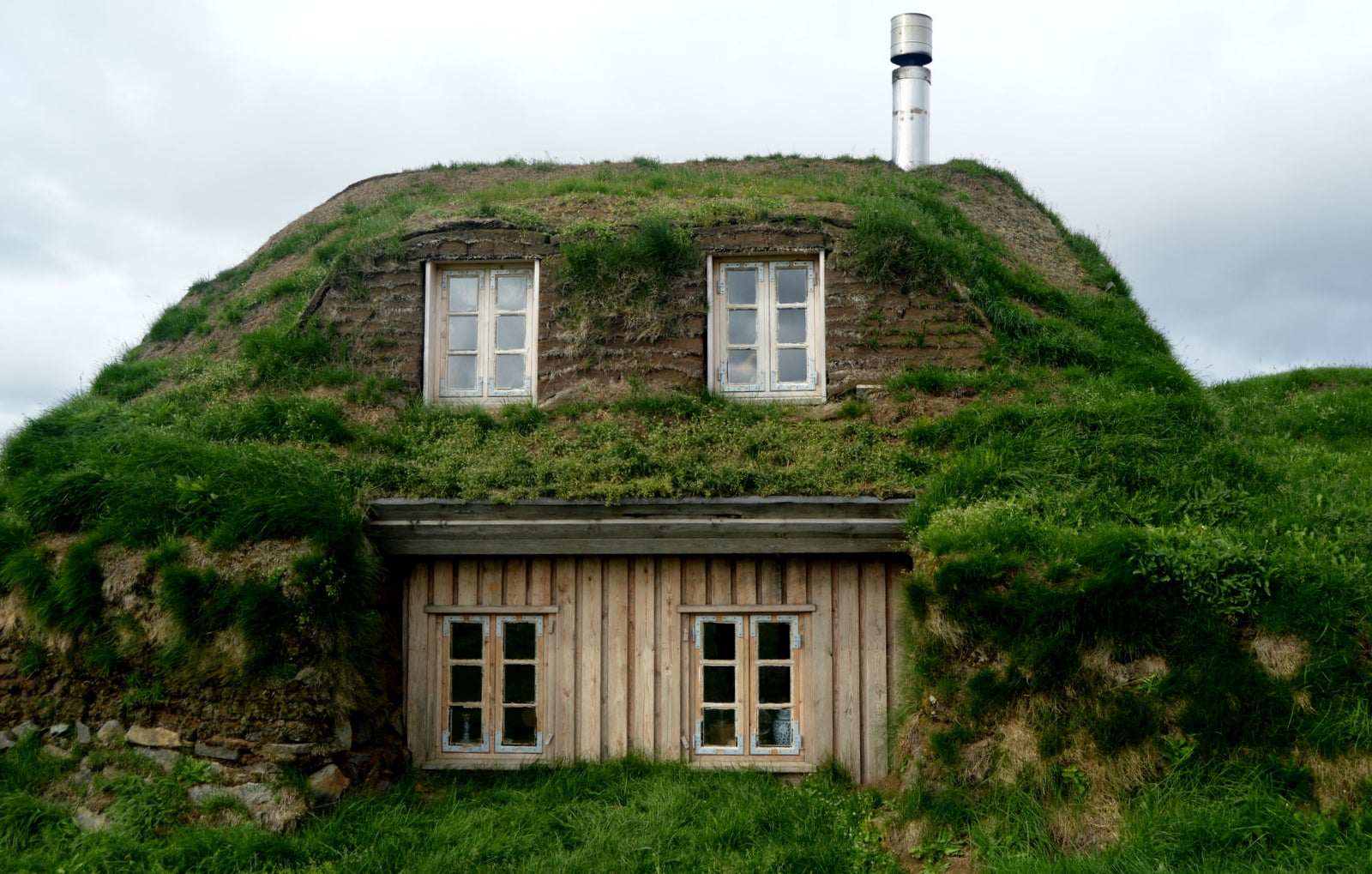Visiting folk museums is something I love doing on my travels in my country. You will find an excellent district museum in South Iceland, which I recommend visiting - Skógar Museum (Skógasafn in Icelandic).
At the museum, you can, f.ex. visit a turf house, but as those of you who have read my travel-blogs, know then I love turf houses and seek them out on my travels in Iceland.
Top photo: the turf house at Skógasafn museum
At Skógar museum
I have written many travel-blogs about the few turf houses left in Iceland, as I want to introduce you to this old architectural heritage, which was the traditional way of building houses in Iceland from the early days of Settlement until the last inhabitants moved out of them in the mid-20th century.
The turf house at Skógar Museum is different from other turf houses in Iceland in that it is a reconstruction of several turf houses from different places in this area.
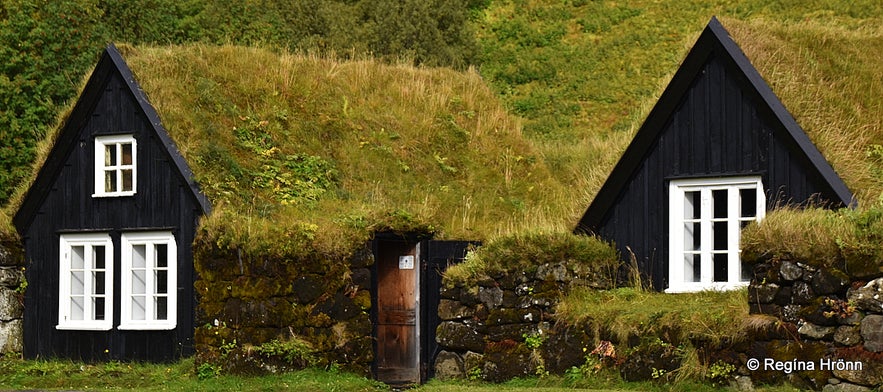
The turf house at Skógasafn museum
This cruciform cowshed dates back to 1880, the storehouse from 1830, "baðstofa", which is the living/sleeping accommodation, dates back to 1895, the kitchen from 1880, the pantry from 1850, the sitting room from 1896 and the bedroom from 1838.
All of them are fully furnished, so one can see how people used to live in the olden days.
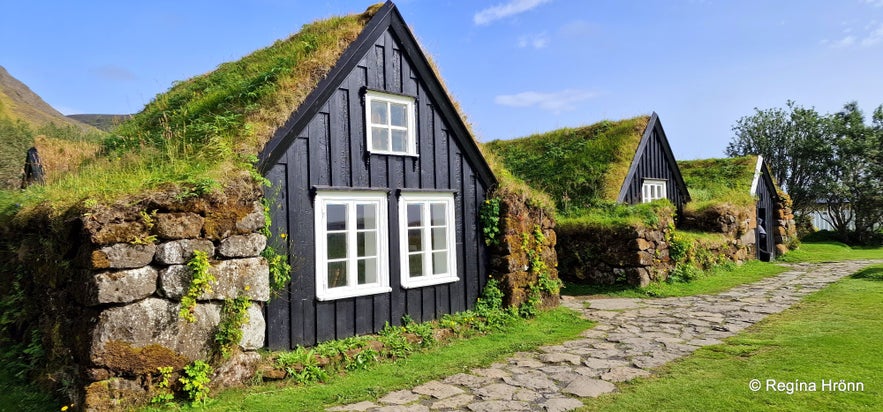 Visiting Skógasafn on a sunny day
Visiting Skógasafn on a sunny day
The first turf house was moved to Skógar in 1968. And six others were moved to Skógar from different locations.
They are so well reconstructed that you would never know that it wasn't a whole turf house from the same location.
The turf house at Skógasafn museum in the wintertime
Skógar Museum is a relatively old museum. It opened on the 1st of December, 1949, and I first visited it when I was 6 years old in 1971, when the very knowledgeable Þórður Tómasson showed us around the museum.
I guess that my interest in folk museums got ignited at Skógar Museum when I listened to a very enthusiastic Þórður tell us about all the artefacts at the museum :)
When we were about to leave the museum, it started raining cats and dogs, and we couldn't go outside. So we got additional quality time with Þórður until the rain stopped.
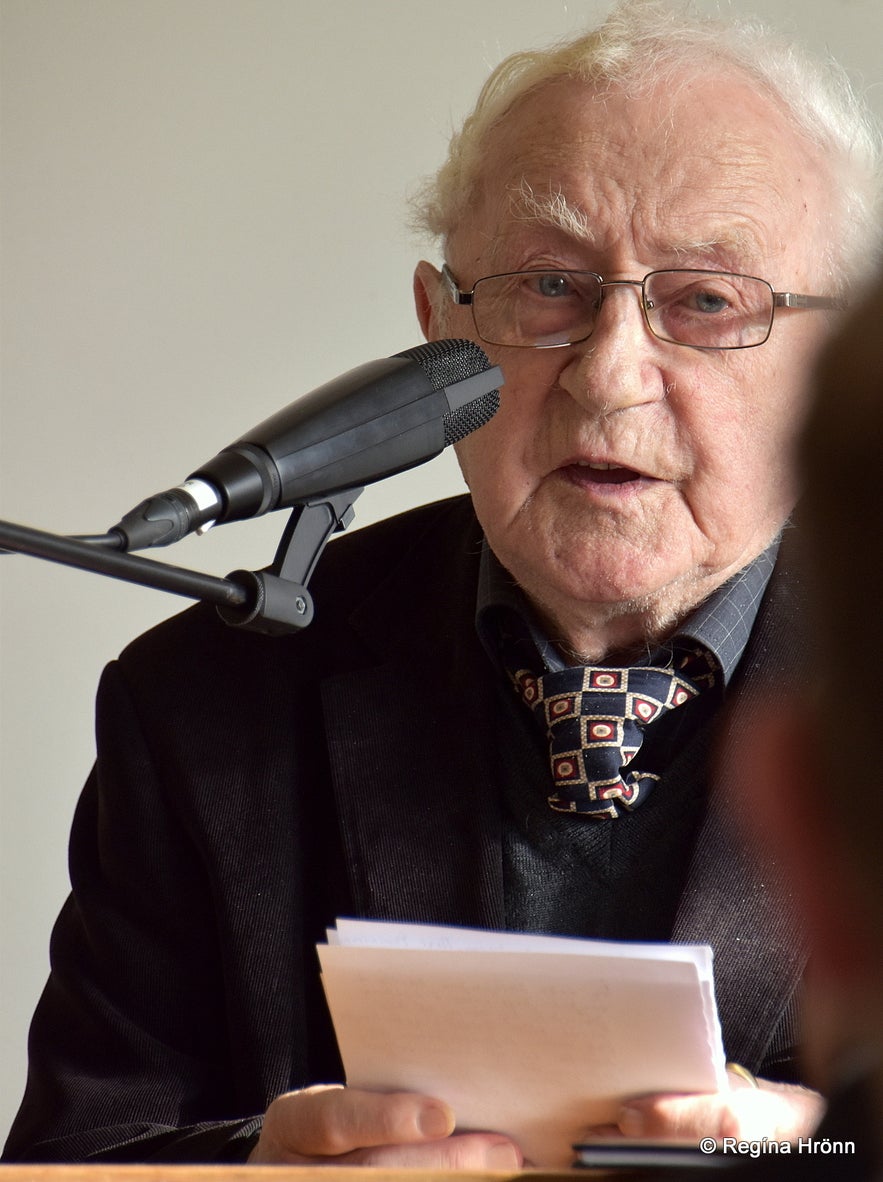
Þórður Tómasson in 2019
Þórður was the instigator, founder, and curator of the museum until he retired in 2014 at age 92 - he turned 100 in 2021! Þórður died on the 27th of January, 2022.
Kudos to him for a job well done - I am very grateful to him for having collected all these artefacts through the decades.
Þórður is also the author of many splendid books about this area, and all in all, he has written some 30 books. I own several of them and thank him for sharing his knowledge with us.
On the 70th anniversary of Skógar Museum, which I attended in the fall of 2019, Þórður (then 98 years old) gave a speech and was applauded for his prolific work.
Skógasafn museum - an old spinning wheel
I visited Skógasafn - Skógar Museum on its 70th anniversary, as this museum, with all its brilliant artefacts, is very dear to me.
In the beginning, the artefacts used to be on display in the summertime only in the cellar of the schoolhouse at Skógar, which served as a hotel in the summertime, so it started small.
I have stayed at this hotel several times and have good memories of this beautiful place.
 Inside one of the turf houses in Skógasafn
Inside one of the turf houses in Skógasafn
From 1945, Þórður started collecting artefacts from this area of South Iceland for the museum, and in 1952, a whole fishing boat, built at and named after the farm and mountain, Pétursey, was donated to the museum - so new facilities were needed for the museum.
Pétursey fishing boat, which was built in 1855, is the jewel in the crown of Skógar Museum, and the new museum was built around it.
In 1959, Þórður moved to Skógar and became the curator of Skógar Museum, and a teacher at the Skógaskóli school.
The fishing boat Pétursey at the Skógasafn museum
Apart from the beautiful turf house at Skógar Museum, there is a school building from 1901 and a Magistrate's House built in 1878 out of driftwood.
Next to it is a farmhouse, built in 1919-1920 with a turf storehouse from 1870.
All of these have been moved from different places in this area of West-Skaftafellssýsla and Rangárvallasýsla counties and reconstructed at the museum.
Skógakirkja church
Skógakirkja church at Skógar
In the outside area of the Skógasafn Museum, you will find Skógakirkja Church, which is relatively new (1998) on the outside, but the interior is old from the Kálfholt church, built in 1879.
All the ecclesiastical artifacts are from different churches in this area, from the 17th and 18th centuries.
There had been a church on this spot since around 1100, and Skógakirkja church was first mentioned in the Church register of Bishop Páll Jónsson at Skálholt from 1200 (kirknaskrá Páls Jónssonar).
Inside Skógakirkja church
There was a church at Skógar until 1890, when the farm churches at Skógar and at Steinar were disused. In 1893, the church objects were auctioned at Steinahellir cave, what a great loss, I say.
Þórður Tómasson wrote a book, Sýnisbók safnamanns (2013), in which he talks about what happened to some of the artifacts.
Many of the church objects are lost, but some of them found their way back to Skógar, amongst them are two chandeliers from Steinakirkja church, which date back to 1767.
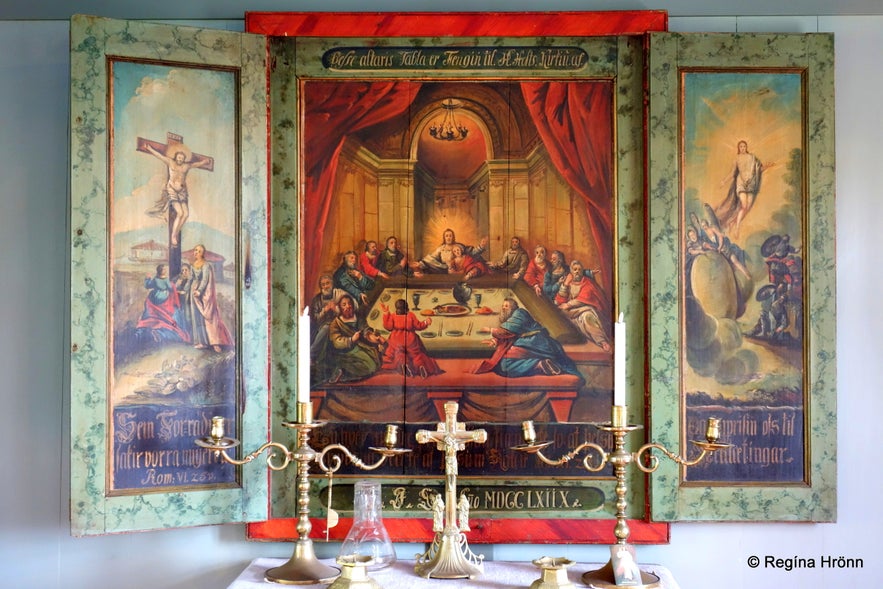 The beautiful triptych dates back to 1768, and the chandeliers date back to 1767
The beautiful triptych dates back to 1768, and the chandeliers date back to 1767
The beautiful triptych, which dates back to 1768, was originally in Holtskirkja church and was moved to the old Ásólfsstaðakirkja church when it was built in 1889.
It is the most valuable object in the Skógakirkja church. It was saved from a fire at the farm Moldnúpur, where it was kept in storage.
Most of the churches from which the artifacts in the new Skógakirkja church originated do not exist anymore, and one of the church bells was most likely saved from a church during the volcanic eruption of the notorious volcano Mt. Katla in 1660.
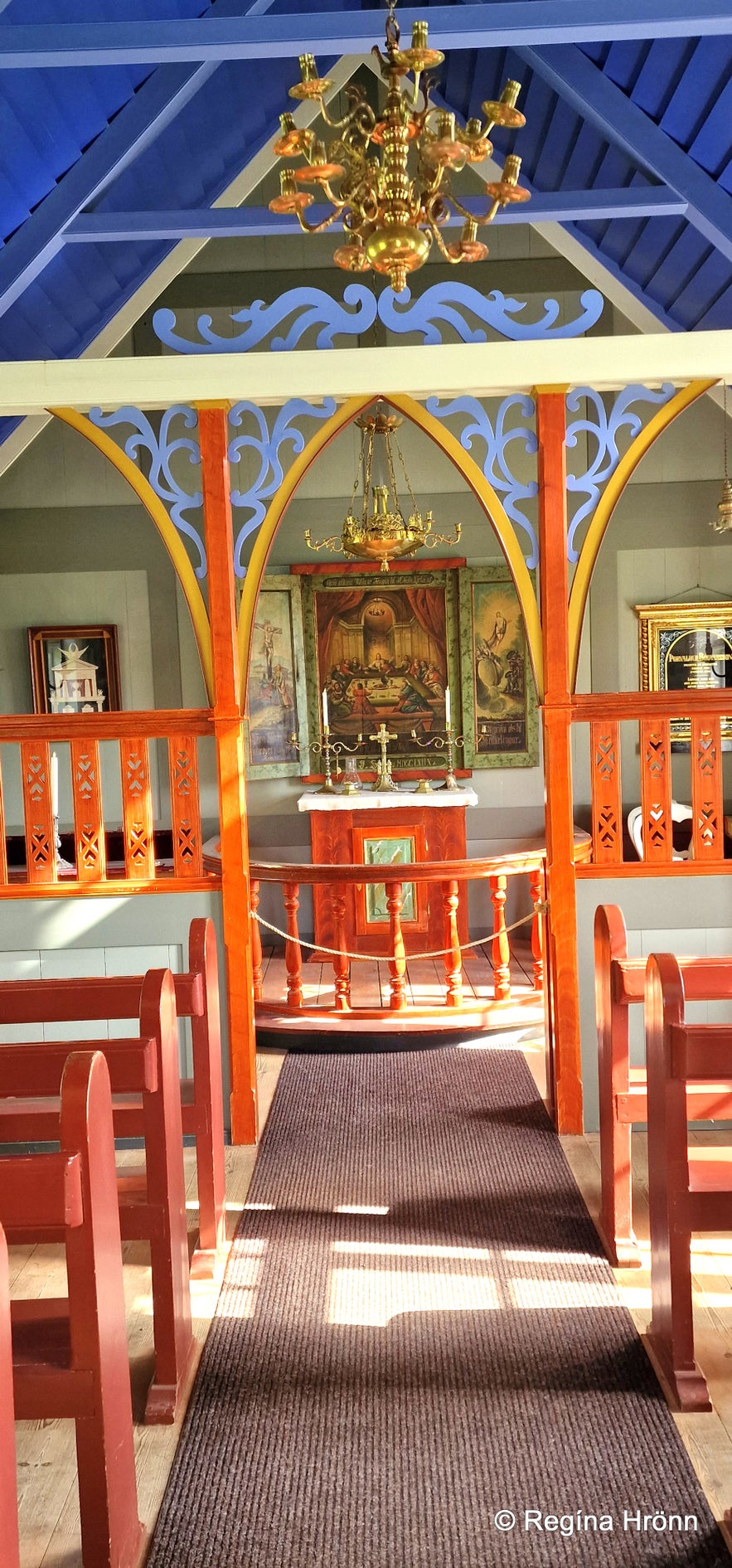 Old chandeliers hang from the ceiling of Skógakirkja church
Old chandeliers hang from the ceiling of Skógakirkja church
The other church bell in Skógakirkja church dates back to 1742, but was originally in Ásakirkja church. Þórður Tómasson acquired both of these invaluable church bells for the Skógasafn Museum.
Þórður Tómasson was instrumental in erecting a new Skógakirkja church at Skógar, and I am grateful for his extraordinary work in collecting the old artifacts from the vicinity.
Just to mention one thing, old chandeliers from Holtskirkja church were sold to the Victoria and Albert Museum in London.
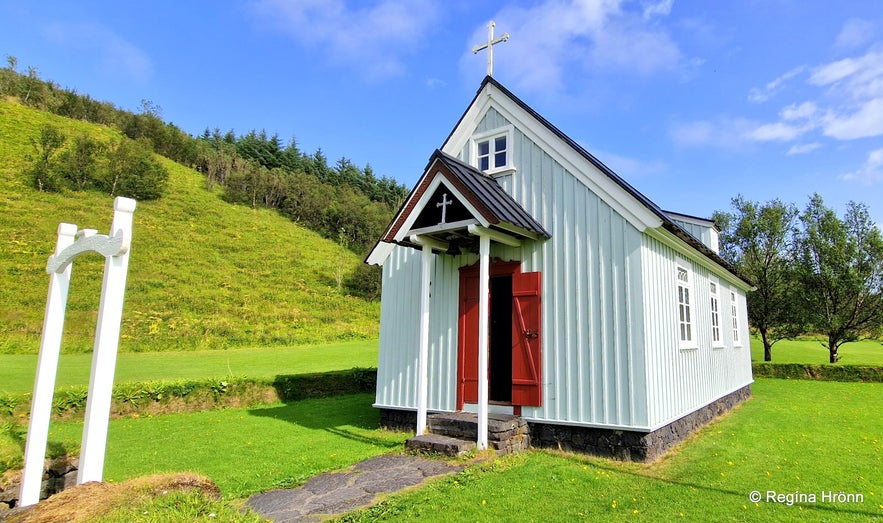 Skógakirkja on a sunny summer day
Skógakirkja on a sunny summer day
The groundbreaking for Skógakirkja was performed by my beloved relative, Rev. Halldór Gunnarsson. The Bishop of Iceland then consecrated the new Skógakirkja church on the 14th of June, 1998.
After visiting the open-air part of the museum, we visited 3 other inside museums with some 18,000 artefacts collected from this region!
The legend of the church ring
The ring from the treasure chest of Þrasi is on display at the Skógasafn museum
At Skógar Museum, you will, among other things, find an artefact which is connected to the legend of the majestic Skógafoss waterfall.
It is believed that behind it, you can find a chest filled with gold and precious treasures.
Þrasi Þórólfsson, the Viking Settler at Skógar (Eystriskógar), in around 900, hid the chest, and it is said that the first man who goes behind the waterfall will find great treasures.
Beautiful Skógafoss waterfall
The legend tells us that Þrasi, who owned a chest filled with gold and treasures, had put the chest beneath Skógafoss waterfall, and in olden times, one could see one side of the chest protruding from the waterfall.
There is an old Icelandic rhyme, which goes like this in English:
"The chest of Þrasi is filled with treasures
located beneath Skógafoss waterfall,
the first man who goes there
will find great richness."
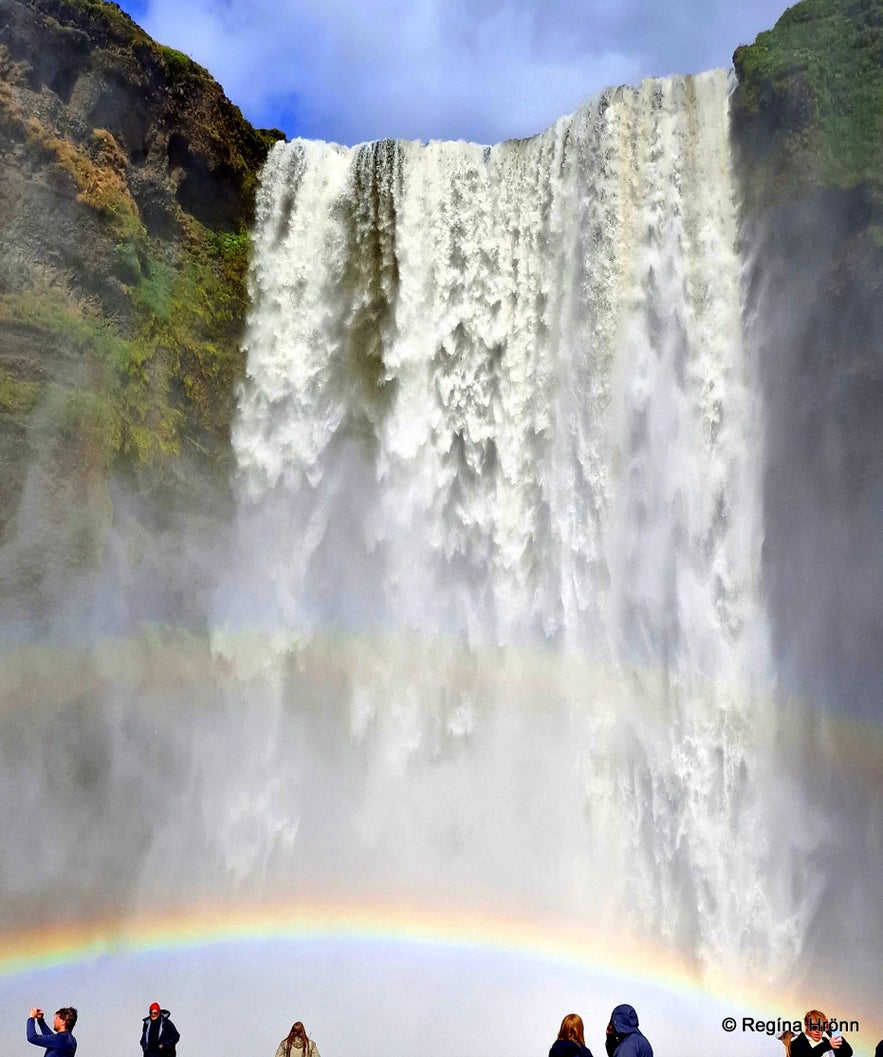 Skógafoss waterfall
Skógafoss waterfall
The story goes that there were once three men at Skógar, the sons of Ámundi Þormóðsson. They wanted to retrieve the chest from beneath the waterfall.
All of a sudden, they looked in the direction of the farm, and it appeared to be on fire - they decided to return, only to find that there was no danger apparent on the farm.
Later on, they decided to go again to the waterfall to retrieve the chest and were not misled by some delusions.
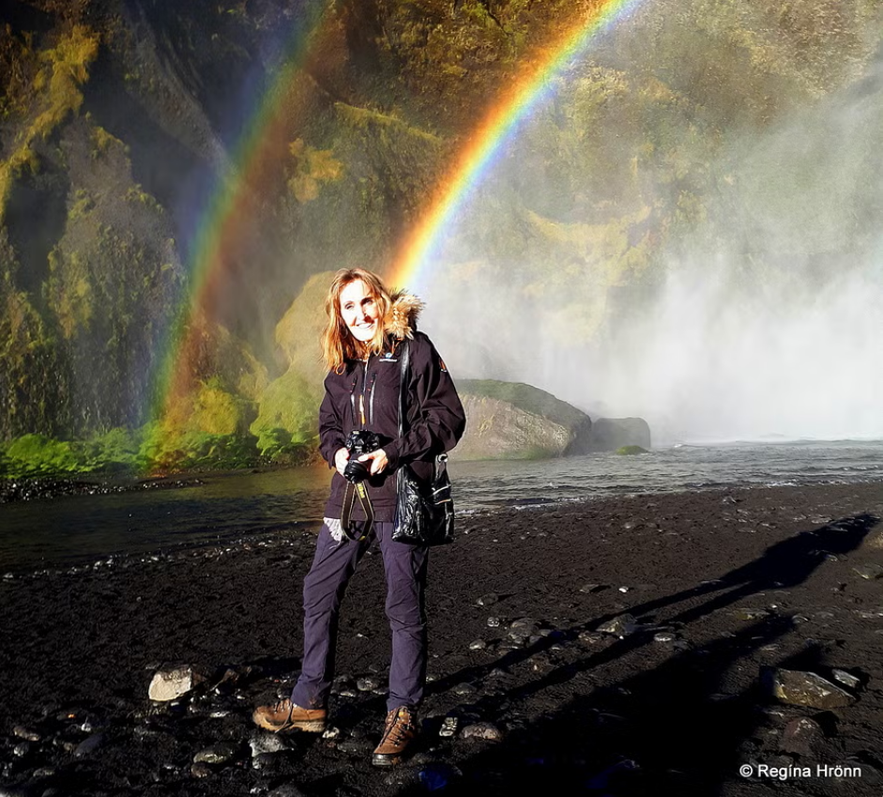
They managed to get quite close to the chest and were able to hook a ring on the side of the chest.
But as they were about to pull the chest towards them, they jerked the ring off the chest, but the chest got left behind.
The story goes that the ring is now located in the church door at Skógar".
(Translated into English from Þjóðsögur Jóns Árnasonar - the Compilation of Folklore of Jón Árnason).
National costumes at Skógasafn museum
There is a myriad of interesting artefacts at the Skógar Museum. Including the old national costumes, which were worn in Iceland by women in the olden days.
I always like this part of the folk museums wherever I go in the world, seeing how people were dressed in the olden days.
And there are some gorgeous national costumes on display at the museum.
Amongst all the many beautiful artifacts, books, and old Bibles, jewellery and personal belongings of people in this area, there is a big colourful tapestry depicting one of the heroes of the old Icelandic Sagas - Gunnar at Hlíðarendi and his wife Hallgerður langbrók.
Gunnar at Hlíðarendi and Hallgerður langbrók
Their story is told in the Saga of Burnt Njáll, which took place in South Iceland.
A guided tour is available of the most important locations of the Saga of Burnt Njáll: The Vikings and the Sagas - a fun and educational tour of South Iceland about which I have written another travel-blog.
Sigríður Einarsdóttir made this eye-catching tapestry at Dufþaksholt - it is a pure gem, as so many of the artefacts at the museum.
Gifts from the Hidden People
Photo from the Skógar Museum guide, published with the permission of the curator of Skógar Museum
Skógar Museum has some extraordinary artefacts on display, amongst them some gifts from the hidden people of Iceland.
During the 70th anniversary in 2019 of Skógar Museum, I searched for the gifts from the hidden people, but couldn't for the life of me find them to photograph them. And everybody was busy celebrating.
So the curator of the museum gave me permission to publish a photo from their museum guide (see the photo above).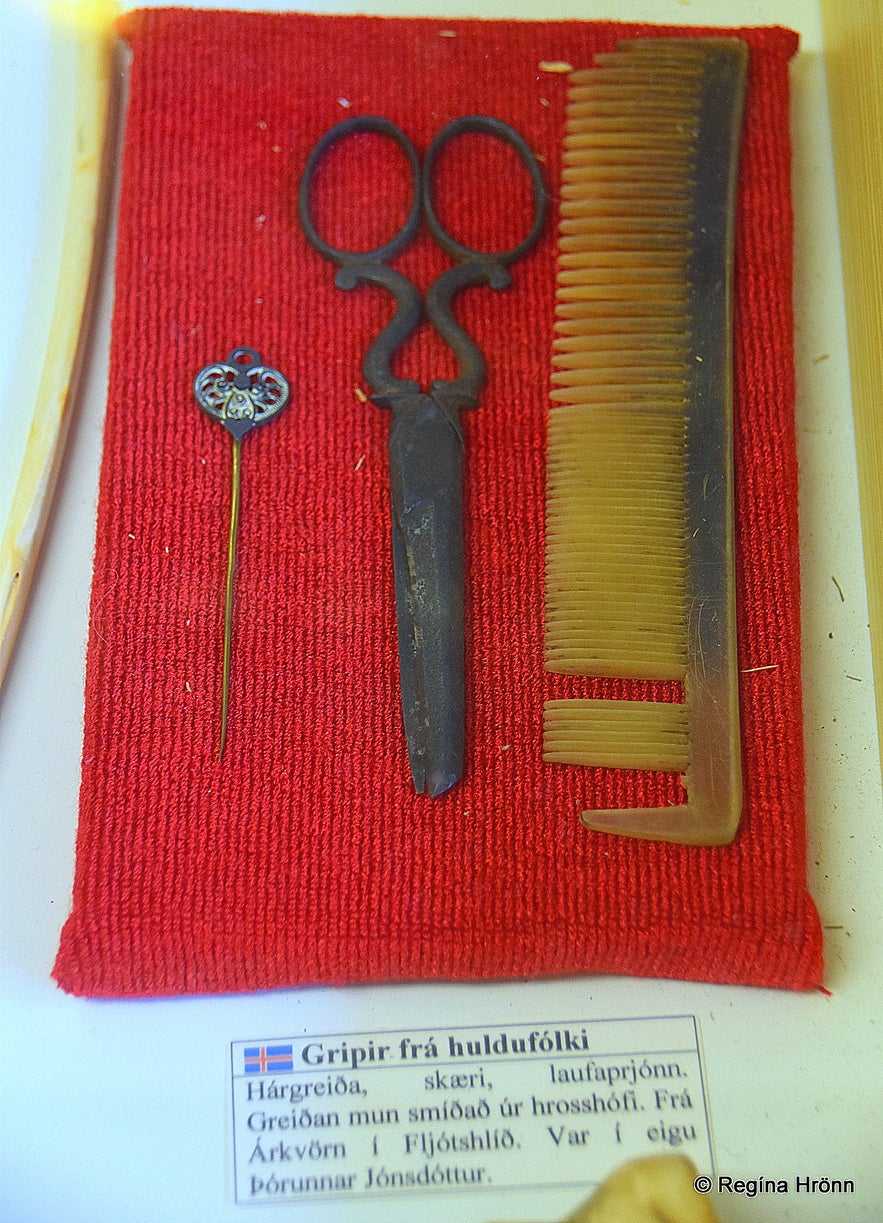
Artefacts of the hidden people of Iceland
A couple of months later, when I next visited the south coast of Iceland, I popped in at Skógar Museum to get a photo of the gifts from the hidden people.
The very knowledgeable lady working at the museum showed me where these hidden people's artefacts were to be found.
I would not have been able to find them by myself, so I was grateful for her help. You will find them if you take a left turn when you enter the museum, then another left turn and walk to the end of the showroom. The gifts from the hidden people will be on your left-hand side.
I took the photo above of the comb, scissors, and pin. The comb is made from the hoof of a horse. Amazing artefacts!

Old artefacts at Skógar Museum
The story goes like this: "Not everybody believed in the existence of the hidden people. Amongst them was Þórunn Jónsdóttir from Árkvörn in Fljótshlíð in South Iceland.
She denied the existence of the hidden people. One night, she dreamt that a hidden woman approached her and said: "You don't believe in our existence, but when you wake up, look into your chest and see what you will find in it".
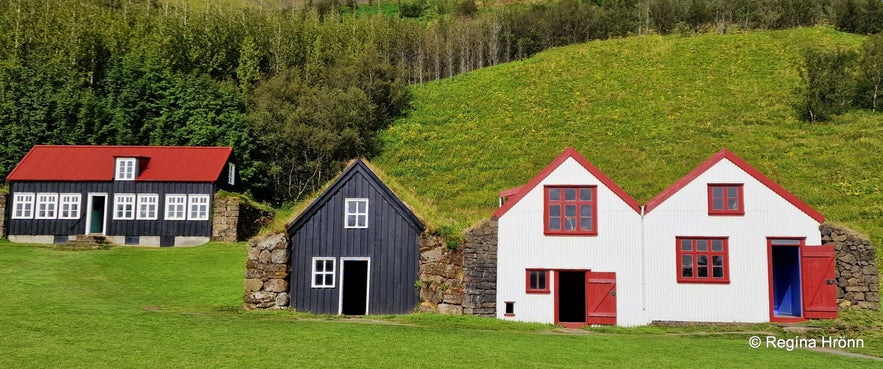 Old houses at Skógasafn - the one with the red roof was made of driftwood in 1878 at Holt at Síða
Old houses at Skógasafn - the one with the red roof was made of driftwood in 1878 at Holt at Síða
The morning after, Þórunn looked into her chest and as she opened it, 3 things lay on top; scissors, a comb and a pin.
From this very day, the woman believed in the existence of the hidden people."
Samgöngusafnið - the Technical Museum at Skógar
Beautiful women saddles at the museum
The Skógar museum grew and grew, and the latest addition is the Museum of Transportation, which opened in 2002. At this museum, one can follow the development of transport in rugged Iceland through the centuries.
This part of the museum is fascinating, as here one can follow the history of how horses and boats were the primary means of transport. And see the early types of snowmobiles and old cars, until modern days.
Here, one can also see the finest examples of women's side saddles from the 18th and 19th centuries (see my photo above).
Old cars at Samgöngusafnið - the Technical Museum at Skógar
On display are several reconstructed old cars, the oldest one from 1917. My photo below shows the first postal car in Iceland from 1931. It was used for postal delivery and passenger transport in the 1930s.
In this section of the Skógar Museum, you will also learn about telecommunications in Iceland, electricity and the electric network, radio communications, the Coast Guard and about Landsbjörg search and rescue.
Old cars at Samgöngusafnið - the Technical Museum at Skógar
Skógar Museum is an excellent museum to visit, with many interesting sights in the vicinity: the majestic Skógafoss waterfall and other interesting waterfalls in this area.
The museum is open all year round - in June, July and August from 09-18 and in September to May from 10-17.
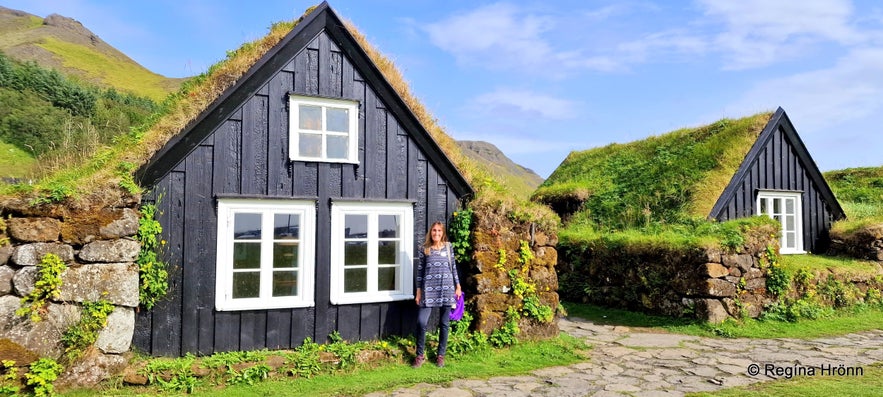
Visiting Skógasafn on a warm and sunny summer day
And if you take a short hike into the gorge behind the museum, you will see a lovely, less-visited waterfall, the beautiful Kvernufoss. Well, it used to be one of the less visited waterfalls, until I posted my travel-blog about it almost 9 years ago.
Skógafoss waterfall and the museum are only some 150 km away from Reykjavík, and to reach it you can rent a car in Reykjavík and make an excellent day tour out of your visit.
Here is the location of Skógasafn museum on Google Maps.
Have a lovely time at beautiful Skógar :)





